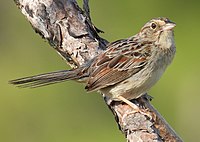
Photo from wikipedia
Background Habitat selection has major consequences on individual fitness, particularly selection for breeding sites such as nests or burrows. Theory predicts that animals will first use optimal habitats or rearrange… Click to show full abstract
Background Habitat selection has major consequences on individual fitness, particularly selection for breeding sites such as nests or burrows. Theory predicts that animals will first use optimal habitats or rearrange their distribution by moving to higher-quality habitats whenever possible, for instance when another resident disperses or dies, or when environmental changes occur. External constraints, such as predation risk or resource abundance, and interindividual differences in age, sex and body condition can lead to variation in animals’ perception of habitat quality. Following habitat use by individuals over their lifetime is thus essential to understand the causes of variation in habitat selection within a population. Methods We used burrow occupancy data collected over eight years to assess burrow-site selection in a population of wild eastern chipmunks (Tamias striatus) relying on pulsed resources. We first compared characteristics of burrow microhabitats with those of equivalent unused plots. We then investigated the factors influencing the frequency of burrow occupation over time, and the individual and environmental causes of annual burrow fidelity decisions. Results Our results indicate that chipmunks select microhabitats with a greater number of woody debris and greater slopes. Microhabitats of burrows with higher occupancy rates had a lower shrub stratum, were less horizontally opened and their occupants’ sex-ratio was skewed towards males. Burrow fidelity was higher in non-mast years and positively related to the occupant’s age, microhabitat canopy cover and density of large red maples. Conclusion The quality of a burrow microhabitat appears to be determined in part by characteristics that favour predation avoidance, but consideration of occupancy and fidelity patterns over several years also highlighted the importance of including individual and contextual factors in habitat selection studies.
Journal Title: PeerJ
Year Published: 2023
Link to full text (if available)
Share on Social Media: Sign Up to like & get
recommendations!